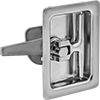Filter by
Mount Type
Latching Distance
Mounting Location
Cam Latch Type
Opens With
Finish
Through-Hole Diameter
Mounting Screw Size
Overall Length
DFARS Specialty Metals
Latch Turn Direction
Latching Distance Adjustability
Strike Plate Material
Weight Capacity
Draw Latch Type
All Results
Building and Machinery Hardware
Electrical
Containers, Storage, and Furniture
























































